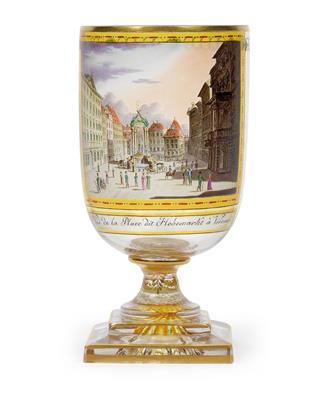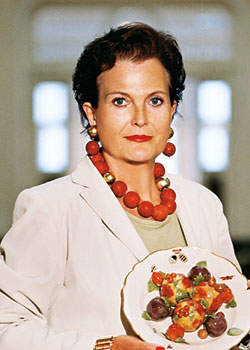An Anton Kothgasser goblet,

glass, colourless, bulbous cylindrical sides with wide and fine gold edges, green painted chain border with rosettes, reserve with transparent colour painted Biedermeier persons, cab and rider as well as the view 'Vue de la Place dit Hohemarkt á Vienne', marked underneath in the field, silver-yellow painted frame with red line border, round foot with golden base and gold painted palmette branches, square plinth with gold edges, base with hollow ribbed foot and black signature A. K. with silver-yellow rays, height 13.6 cm, very rare shape, Anton Kothgasser, Vienna around 1815 (Ru)
See Lit.:
Gustav E. Pazaurek, Eugen von Philippovich, Gläser der Empire- und Biedermeierzeit, 1976, p 189, fig. 169;
Lit.:
Kovacek, Katalog Biedermeier, Einblicke in die Idylle, 2007, p. 74, cat. no. 41, the same goblet as lot 812... edge of the indented bottom signed A. K. in black;
Lit.:
Paul von Lichtenberg, Mohn & Kothgasser, Transparent bemaltes Biedermeierglas, 2009, p 305, fig. 191, the same goblet form without signature A. K. but with identical painting, except the lady on the left in the foreground is dressed in a light green dress, the right one with a light crimson dress.
Anton Kothgasser, Vienna, 1769–1851, porcelain and glass painter from 1781 at the Wiener Kunstakademie, studied figural drawing with German painter Heinrich Füger, from 1784 at the Wiener Porzellanmanufaktur to 1840, employed as their most significant design painter, painter no. 96. From 1811, next to working for the Manufaktur and independently of it, he addressed glass painting, to which he was introduced by Gottlob Samuel Mohn, who was twenty years younger than him and had moved to Vienna in 1811. He received numerous awards, among others on 6 September 1811, and the permission on 20 May 1816 'to work at home for some months at his glass painting'. He first dedicated himself to sheet glass painting, but soon preferred hollow glass painting using transparent enamel colour (transparent painting). This technique was invented by Samuel Mohn, who was particularly focused on this method between 1815 and 1830.
Expert: Ursula Rohringer
 Ursula Rohringer
Ursula Rohringer
+43-1-515 60-382
ursula.rohringer@dorotheum.at
26.04.2018 - 15:00
- Dosažená cena: **
-
EUR 12.500,-
- Odhadní cena:
-
EUR 8.000,- do EUR 9.000,-
An Anton Kothgasser goblet,
glass, colourless, bulbous cylindrical sides with wide and fine gold edges, green painted chain border with rosettes, reserve with transparent colour painted Biedermeier persons, cab and rider as well as the view 'Vue de la Place dit Hohemarkt á Vienne', marked underneath in the field, silver-yellow painted frame with red line border, round foot with golden base and gold painted palmette branches, square plinth with gold edges, base with hollow ribbed foot and black signature A. K. with silver-yellow rays, height 13.6 cm, very rare shape, Anton Kothgasser, Vienna around 1815 (Ru)
See Lit.:
Gustav E. Pazaurek, Eugen von Philippovich, Gläser der Empire- und Biedermeierzeit, 1976, p 189, fig. 169;
Lit.:
Kovacek, Katalog Biedermeier, Einblicke in die Idylle, 2007, p. 74, cat. no. 41, the same goblet as lot 812... edge of the indented bottom signed A. K. in black;
Lit.:
Paul von Lichtenberg, Mohn & Kothgasser, Transparent bemaltes Biedermeierglas, 2009, p 305, fig. 191, the same goblet form without signature A. K. but with identical painting, except the lady on the left in the foreground is dressed in a light green dress, the right one with a light crimson dress.
Anton Kothgasser, Vienna, 1769–1851, porcelain and glass painter from 1781 at the Wiener Kunstakademie, studied figural drawing with German painter Heinrich Füger, from 1784 at the Wiener Porzellanmanufaktur to 1840, employed as their most significant design painter, painter no. 96. From 1811, next to working for the Manufaktur and independently of it, he addressed glass painting, to which he was introduced by Gottlob Samuel Mohn, who was twenty years younger than him and had moved to Vienna in 1811. He received numerous awards, among others on 6 September 1811, and the permission on 20 May 1816 'to work at home for some months at his glass painting'. He first dedicated himself to sheet glass painting, but soon preferred hollow glass painting using transparent enamel colour (transparent painting). This technique was invented by Samuel Mohn, who was particularly focused on this method between 1815 and 1830.
Expert: Ursula Rohringer
 Ursula Rohringer
Ursula Rohringer
+43-1-515 60-382
ursula.rohringer@dorotheum.at
|
Horká linka kupujících
Po-Pá: 9.00 - 18.00
kundendienst@dorotheum.at +43 1 515 60 200 |
| Aukce: | Starožitnosti - Mobili, sculture, vetri e porcellane |
| Typ aukce: | Salónní aukce |
| Datum: | 26.04.2018 - 15:00 |
| Místo konání aukce: | Wien | Palais Dorotheum |
| Prohlídka: | 14.04. - 26.04.2018 |
** Kupní cena vč. poplatku kupujícího a DPH
Není již možné podávat příkazy ke koupi přes internet. Aukce se právě připravuje resp. byla již uskutečněna.
